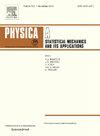Reduction strategy of rear-end collision risks for connected and automated vehicles on freeways with different weather conditions
IF 3.1
3区 物理与天体物理
Q2 PHYSICS, MULTIDISCIPLINARY
Physica A: Statistical Mechanics and its Applications
Pub Date : 2025-06-06
DOI:10.1016/j.physa.2025.130761
引用次数: 0
Abstract
Car-following behavior is significantly influenced by weather conditions. Adverse weather conditions, in particular, negatively affect this behavior and increase rear-end collision risks. Equipped with advanced technologies, connected and automated vehicles (CAVs) have potential in reducing collision risks. To mitigate the collision risks of mixed fleet with CAVs and human-driven vehicles (HVs) on freeways with various weather conditions, this paper proposes a distance-based control strategy for CAVs. Specifically, the Gipps model was employed to represent car-following behavior of HVs under different weather conditions. Based on this, a car-following strategy for CAVs is developed to enhance their adaptability to distance situations with the vehicle ahead. To validate the effectiveness of the proposed CAV strategy, simulation experiments under both speed homogeneity and heterogeneity conditions were conducted, which analyzed the effects of weather condition, vehicle speed, and CAV penetration rate on rear-end collision risks. Furthermore, we examined how distribution patterns of CAVs in mixed fleet influenced the rear-end collision risk. The results demonstrate that the proposed CAV strategy can effectively enhance fleet stability and reduce rear-end collision risks caused by emergency braking under clear, rainy, and foggy freeway conditions. When compared to a fleet of pure HVs, reduction in surrogate measures of ITC and DRAC exceeds 75 % and 60 %, respectively, at different speed levels for a fleet of pure CAVs. Additionally, during the early stages of CAVs adoption on freeways, it is recommended to place CAVs in the middle of the mixed fleet across different weather conditions. As CAVs become more widely adopted, they are suggested to be positioned at the front of the mixed fleet to minimize the overall rear-end collision risks. While the speed heterogeneity weakens this trend, the minimum collision risk occurs when CAVs position in the front of the mixed fleet.
不同天气条件下高速公路网联与自动驾驶车辆追尾风险降低策略
汽车跟随行为受天气条件的显著影响。尤其是恶劣的天气条件,会对这种行为产生负面影响,并增加追尾碰撞的风险。配备了先进技术的联网和自动驾驶汽车(cav)在降低碰撞风险方面具有潜力。为了降低自动驾驶汽车与人类驾驶汽车混合车队在不同天气条件下高速公路上的碰撞风险,提出了一种基于距离的自动驾驶汽车控制策略。具体而言,采用Gipps模型来表示不同天气条件下HVs的跟车行为。在此基础上,提出了一种自动驾驶汽车跟随策略,以提高自动驾驶汽车对前方车辆距离情况的适应能力。为验证所提CAV策略的有效性,在速度均匀性和非均匀性条件下进行了仿真实验,分析了天气条件、车速和CAV渗透率对追尾风险的影响。此外,我们还研究了混合车队中自动驾驶汽车的分布模式对追尾碰撞风险的影响。结果表明,在晴朗、多雨和多雾的高速公路工况下,CAV策略能有效提高车辆稳定性,降低紧急制动引起的追尾风险。与纯HVs车队相比,在不同的速度水平下,纯cav车队的替代测量值ITC和DRAC的降低分别超过75% %和60% %。此外,在高速公路上采用自动驾驶汽车的早期阶段,建议将自动驾驶汽车放在混合车队的中间,以应对不同的天气条件。随着自动驾驶汽车被广泛采用,建议将其放置在混合车队的前部,以最大限度地降低整体追尾风险。而速度的非均质性削弱了这一趋势,当自动驾驶汽车处于混合车队的最前端时,碰撞风险最小。
本文章由计算机程序翻译,如有差异,请以英文原文为准。
求助全文
约1分钟内获得全文
求助全文
来源期刊
CiteScore
7.20
自引率
9.10%
发文量
852
审稿时长
6.6 months
期刊介绍:
Physica A: Statistical Mechanics and its Applications
Recognized by the European Physical Society
Physica A publishes research in the field of statistical mechanics and its applications.
Statistical mechanics sets out to explain the behaviour of macroscopic systems by studying the statistical properties of their microscopic constituents.
Applications of the techniques of statistical mechanics are widespread, and include: applications to physical systems such as solids, liquids and gases; applications to chemical and biological systems (colloids, interfaces, complex fluids, polymers and biopolymers, cell physics); and other interdisciplinary applications to for instance biological, economical and sociological systems.

 求助内容:
求助内容: 应助结果提醒方式:
应助结果提醒方式:


